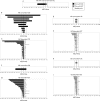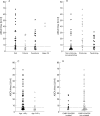Anti-Saccharomyces cerevisiae antibodies in twins with inflammatory bowel disease
- PMID: 15863472
- PMCID: PMC1774647
- DOI: 10.1136/gut.2005.066860
Anti-Saccharomyces cerevisiae antibodies in twins with inflammatory bowel disease
Abstract
Background and aims: An increased occurrence of anti-Saccharomyces cerevisiae antibodies (ASCA) is reported in unaffected members of families with Crohn's disease. Whether ASCA is a familial trait due to genetic factors or is caused by exposure to environmental factors is unknown. To assess the genetic influence of ASCA we studied its occurrence in a twin population.
Patients and methods: ASCA were analysed in 98 twin pairs with inflammatory bowel disease and were related to clinical phenotype and CARD15/NOD2 genotype.
Results: ASCA were more common in Crohn's disease than in ulcerative colitis (40/70 (57%) twins v 5/43 (12%) twins). Associations with ileal Crohn's disease, stricturing/penetrating behaviour, and young age, but not CARD15/NOD2 were confirmed. ASCA were found in 1/20 (5%) healthy siblings in discordant monozygotic pairs with Crohn's disease compared with 7/27 (26%) in discordant dizygotic pairs. Using the intraclass correlation coefficient (ICC), no agreement in ASCA titres was observed in discordant twin pairs with Crohn's disease, in monozygotic (ICC = -0.02) or dizygotic (ICC = -0.26) pairs. In contrast, strong agreement was seen within concordant monozygotic twin pairs with Crohn's disease (ICC = 0.76).
Conclusions: These findings question the concept of ASCA as a marker of genetic susceptibility for Crohn's disease. The agreement in ASCA titres within concordant monozygotic twin pairs with Crohn's disease, suggests that the level of increase is genetically determined. We propose that ASCA are a marker of a response to an environmental antigen and that a specific gene(s) other than CARD15/NOD2 determines the level of response and perhaps also specific phenotypic characteristics.
Figures


Similar articles
-
Concordance in Anti-OmpC and Anti-I2 Indicate the Influence of Genetic Predisposition: Results of a European Study of Twins with Crohn's Disease.J Crohns Colitis. 2016 Jun;10(6):695-702. doi: 10.1093/ecco-jcc/jjw021. Epub 2016 Jan 27. J Crohns Colitis. 2016. PMID: 26818662
-
CARD15/NOD2 polymorphisms do not explain concordance of Crohn's disease in Swedish monozygotic twins.Dig Liver Dis. 2005 Oct;37(10):768-72. doi: 10.1016/j.dld.2005.05.005. Dig Liver Dis. 2005. PMID: 16002353
-
CARD15 polymorphisms are associated with anti-Saccharomyces cerevisiae antibodies in caucasian Crohn's disease patients.Clin Exp Immunol. 2005 May;140(2):354-9. doi: 10.1111/j.1365-2249.2005.02759.x. Clin Exp Immunol. 2005. PMID: 15807862 Free PMC article.
-
CARD15 mutations in Dutch familial and sporadic inflammatory bowel disease and an overview of European studies.Eur J Gastroenterol Hepatol. 2007 Jun;19(6):449-59. doi: 10.1097/01.meg.0000236887.44214.6a. Eur J Gastroenterol Hepatol. 2007. PMID: 17489054 Review.
-
Familial occurrence and inheritance studies in inflammatory bowel disease.Neth J Med. 1996 Feb;48(2):53-6. doi: 10.1016/0300-2977(95)00093-3. Neth J Med. 1996. PMID: 8819799 Review.
Cited by
-
Association of levels of antibodies from patients with inflammatory bowel disease with extracellular proteins of food and probiotic bacteria.Biomed Res Int. 2014;2014:351204. doi: 10.1155/2014/351204. Epub 2014 Jun 4. Biomed Res Int. 2014. PMID: 24991549 Free PMC article.
-
Antibody markers in the diagnosis of inflammatory bowel disease.World J Gastroenterol. 2016 Jan 21;22(3):1304-10. doi: 10.3748/wjg.v22.i3.1304. World J Gastroenterol. 2016. PMID: 26811667 Free PMC article. Review.
-
The role of mycobiota-genotype association in inflammatory bowel diseases: a narrative review.Gut Pathog. 2021 May 8;13(1):31. doi: 10.1186/s13099-021-00426-4. Gut Pathog. 2021. PMID: 33964975 Free PMC article. Review.
-
Serological markers (anti-Saccharomyces cerevisiae mannan antibodies and antineutrophil cytoplasmic antibodies) in inflammatory bowel disease: diagnostic utility and phenotypic correlation.Clin Diagn Lab Immunol. 2005 Nov;12(11):1328-30. doi: 10.1128/CDLI.12.11.1328-1330.2005. Clin Diagn Lab Immunol. 2005. PMID: 16275949 Free PMC article.
-
Host-microbiome interaction in Crohn's disease: A familiar or familial issue?World J Gastrointest Pathophysiol. 2015 Nov 15;6(4):159-68. doi: 10.4291/wjgp.v6.i4.159. World J Gastrointest Pathophysiol. 2015. PMID: 26600974 Free PMC article. Review.
References
Publication types
MeSH terms
Substances
LinkOut - more resources
Full Text Sources
